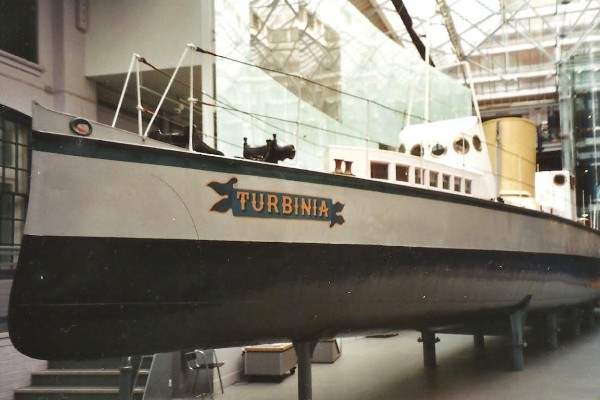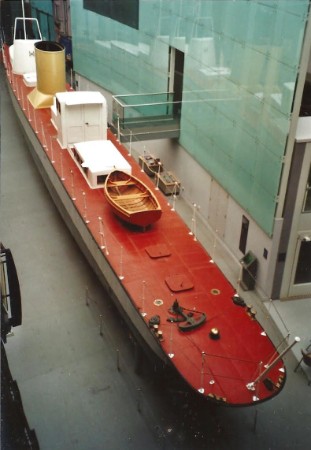Turbinia
This ship is a little side-step for Castles Of The Seas, because it is not a passengership. Of course, the ship pictured below is one of the most famous ships in liner history, although she isn't one and she hasn't been one too. But her importance to the world of passengershipping has been immense, and still is immense so I really wanted to add her to this site. She was designed by Sir Charles Parsons, one of the most famous British engineers. He was born in London in 1854, but raised in Parsonstown, Ireland. He studied in Cambridge to become a marine engineer and he started his working life at Elswick Works of W.G. Armstrong & Co. at the river Tyne, Newcastle. In 1884, he started working on inventing a new kind of engine when he worked with Clarke, Chapman & Co. of Gateshead. He designed a steam turbine engine that could drive a dynamo for generating electricity, where the force of steam was used to drive blades on a rotor. He patented his engine at the 23rd of april 1884 and the company started building these engines to provide lighting aboard ships, the first ship the new engine lit was the Earl Percy that sailed for the Tyne Steam Shipping Company. In 1889, Parsons left the company and set up his own, C.A. Parsons & Co. to devellop the engine further. For this, he set up a works at Heaton, Newcastle. Although lighting ships with his new invention was of course a great achievement, he quickly realized other potentials for the engine, namely to propel ships at high speeds across the worlds oceans. For this, he had to build a prototype ship of his own, and this became the steamyaught Turbinia.

Turbinia as seen on display at the Discovery Museum in Newcastle at the 26th of april 2007.
Charles Parsons designed the ship by himself, largely, although he was not a naval architect. The first modeltests were carried out at a pond at Ryton-on-Tyne. In 1894, work started at the Brown & Hood works at Wallsend for a full-size ship, firstly just named 'The boat' or 'The experimental launch', but later named Turbinia, a fitting name. The ship was launched at the 2nd of august 1894. She has a lenght of 103 feet and 9 inches, a beam of just 9 feet and a draft of 3 feet. Her tonnage measurement was 44,5 and she was to be manned by 10 people. Of course, the machinery was manufactured by the Heaton works. Firstly, a radial flow-type turbine was installed and just one propeller to drive the ship. But this gave the ship just a speed of 20 knots, something that was way too low for what Parsons wanted to achieve. By the way, for a ship that was built in 1894, it was already a great achievement! After a lot of rethinking, Turbinia was fitted with three efficient parallel flow-type turbine engines that were linked to three propellershafts, each one driving three propellers, so the ship had now nine propellers in total. These engines produced the staggering amount of 2000 horsepower. In new testings, the ship managed to reach a speed up to 30 knots throughout the end of 1894. Of course, these speeds were not matched by any other ship in the world, so it was not really a surprise that she suffered a collission with the freighter North Tyne while she attempted the speed records in november of that year. Also lucky encounters were there, of course. Like one time when Turbinia met a warship in the mouth of the Tyne river and Parsons brought his ship up to 28 knots to overtake the ship. This of course was not a problem for Turbinia and the warship gave a blast on the siren to admit its defeat. But to really show off her capabilities, the ship had to be in some sort of public display, watched by many. This opportunity came at the 26th of june 1897, at the Admirality Fleet Review at Spithead, between Portsmouth and the Isle of Wight.
At this fleet review, a great number of Royal Navy ships were present, as well as some foreign warships from allied countries like Prussia. Also, a lot of high-ranked naval officers were there, next to members of the House of Lords, MP's and ambassadors from other countries. Most important, the Prince of Wales was present to represent his mother Queen Victoria and also Prince Henry of Prussia attended. The total number of ships from the Royal Navy was 140 and they were spread out for 25 miles. Also, some passengerliners attended, like the Campania from Cunard Line and the Carthage of the P&O Line. Of course, the Royal Yaught Victoria and Albert was present too, carriing the Prince Of Wales. Parsons and his Turbinia were not invited, but they managed to come very close and just when the Royal procession had passed, Parsons had Turbinia accelerating up to a speed of 34,5 knots, steaming through a line of battleships and cruisers, including the König Wilhelm that carried Prince Henry of Prussia. The ship nearly collided with a French yaught and was chased by several boats that were there to keep the lines clear of intruders, but Turbinia as not to be overtaken. Later during the review, Parsons again interrupted the lines of ships, this time very close to the Royal Yaught. Of course, some minds were very angry that someone dared to do so, but at least one person was very impressed, Prince Henry of Prussia. And of course, this interest from Prussia did also attract the atention of the Royal Navy itself. When Prussian boats would be fitted with the new engine, British boats had to be fitted with them too. All in all, the uninvited showcase of Turbinia was a great success. One year after the Fleet Review, the British Admirality were the first to order two ships to be fitted with the new engines. For this, Parsons founded the Turbinia Wharf at Newcastle to built the engines.

The first ship to be launched with the new engines was the Royal Navy torpedo-boat destroyer HMS Viper in 1898. This ship was followed by a sistership, the HMS Cobra. For Turbinia herself, the last years of the 19th century gave her the opportunity to sail at the Northsea with invited guests, as well as these years gave Parsons the extra time to devellop and study the engine.
In 1900, Turbinia set sail for Paris twice, to attend at the Paris Expedition where she docked at the Seine river. It was a hazardous undertaking, but all went well.
Not all was good, though. In august 1901, HMS Viper was lost near Alderney, at the Channel Islands. One month later, also HMS Cobra was lost near the Lincolnshire coast. Although it was clear that the engine had not been the problem, Parsons suffered a real setback and he was truly horrofied by the loss of these ships. His company had also lost something on a personal level, as one of the men who perished was the helmsman of Turbinia and a close friend to Charles Parsons himself. Turbinia, a good friend and colleague of Parsons who served on HMS Viper at the time she was lost.
The Navy showed they were still devoted to the new engine, when they ordered a new ship to be fitted with the Parsons turbine, the HMS Velox. This ship was followed by two others, the HMS Eden and HMS Amethyst. Because of the success of these ships, the Navy issued that all new Naval ships had to be equipped with the engine, of course a great achievement for Parsons. In 1906, the big battleship Dreadnaught was equipped with the Parsons engines, as well as the German battlecruiser Von Der Tann in 1910. Meanwhile, in 1901, the first passengership to recieve the engines was the Clyde pleasuresteamer King Edward. A big breakthrough came in 1905, when the first transatlantic liners were fitted with the engines. These were the Virginian and the Victorian of the Allan Line. Cunard Line fitted their new Carmania at the end of 1905 with Parsons turbine. This was an expreriment, though. Carmania's sistership Caronia was fitted with traditional reciprocating engines so the differences between the two could be monitored. Soon, it became clear that the turbines were superiour, so Cunard Line decided to built the turbines into their new large express steamers Mauretania and Lusitania. This really gave the Parsons engine the final push to become the superiour way of propelling ships across the worlds oceans, the dream of Parsons. These ships were the biggest ships in the world, measuring 31.000 tons. As a final conclusion, Mauretania took the famous Blue Ribband and held the speedrecord across the Atlantic untill 1929. It was meant for Turbinia to sail alongside her big daughter when Mauretania was leaving the Tyne, but due to a problematic air pump she had to stay put when the large liner sailed by. Just when Mauretania was introduced in 1907, Turbinia almost found her end when she was nearly split in two by the ship Crosby that was launched at the river Tyne opposite the Heaton works, where the ship was docked. The ship was repaired, but because she had proved her advantages, she was given her rest. The ship was no longer required and was put on display at the quayside of the Turbinia Works.
In 1927, the ship was halved and the sternpart was sold to the Science Museum in London to be displayed. In 1944, also her bowpart was sold to the Newcastle Corporation for use on display at the new Exhibition Park at Newcastle. This dual exhibitions were ended in 1959, when both parts of the ship were finally re-united and the ship was now on display as a whole at the Newcastle Exhibition Park from 1961 onwards. The ship was taken off from display in 1983, when she was restored by the Tyne & Wear Museums to her original state, meaning the state she was in when she sailed her historic Spithead Fleet Review interruptions. The restoration was finally completed in 1994 and on the 30th of october 1994, the ship was 'sailing' through the streets of Newcastle to her new home at the Newcastle Discovery Museum. A special gallery was built by the museum to display the ship, and this is where she remains today. The gallery opened in march 1996 and so one of the most important ships for marine history is now still to be seen.
When I took a minicruise by DFDS Seaways from IJmuiden to Newcastle in 2007, I did not know that Turbinia still exsisted and I was very gladly surprised to find her at the museum. Of course, a ship does not belong inside a waterless museum. But at least she survived and an important part of history is to be found near the Tyne river, a river that has been so important in liner history. Next to the Turbinia, the Discovery Museum also houses a display of some artefacts from Turbinia's daughter Mauretania. For a shipfreak, it is truly a must to visit.

